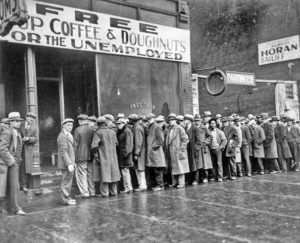Five Causes of The Great Depression

On Black Monday, Oct. 28, 1929, the Dow Jones dropped nearly 13% in one day. That started a period of catastrophic declines that destroyed almost half of the Dow’s value in a single month. By 1932, at the nadir of the financial crisis, the nation’s public companies had lost 89% of their value. And the US economy didn’t fully recover from the damage that had been done until after WWII.
Why did it happen? Experts point to these contributing factors:
- Credit-fueled Consumption: After WWI, consumers went on a spending spree, using credit to buy everything from radios and washing machines to real estate and cars.
- Financial Speculation: The economic boom of the 1920s bred a frenzy of get-rich-quick scams. But the riskiest gambling took place on Wall Street, with more and more investors buying stocks on margin.
- The Federal Reserve: To fuel recovery after WWI, the Fed had lowered interest rates. Spending increased… but so did uncontrolled borrowing and speculation. As a result, in 1929, the Fed slammed on the brakes, jacked up interest rates, and caused a (justified, in my view) panic. The high interest rates made it difficult for businesses to borrow the money they needed to survive, and many ended up closing their doors.
- The Gold Standard: In 1929, the United States – like many other countries at the time – was on the gold standard, a system that directly links the value of a country’s paper currency to the value of a fixed amount of gold. A slowing economy, combined with the stock market crash and subsequent wave of bank failures, had led to crippling levels of deflation. And being on the gold standard made it impossible for the Fed to increase the money supply to stimulate the economy.
- The Smoot-Hawley Act: Signed into law in 1930, the Act raised already-high US import duties by an average of 20%. It was intended to protect the interests of American farmers and other US businesses, but the move backfired when foreign countries retaliated with their own tariffs. International trade plummeted by 65%, with US exports falling from $7 billion in 1929 to $2.5 billion in 1932.
These are the “five” causes that, as I said, “experts” often cite. And for good reason. From a long-distance and retrospective viewpoint, they all played a role in the drama. But the last three “causes” weren’t really causes, but effects.
At bottom, there were really two causes of The Great Depression: irresponsible speculation and irresponsible debt. (I’ll explain more next week.)
 MarkFord
MarkFord